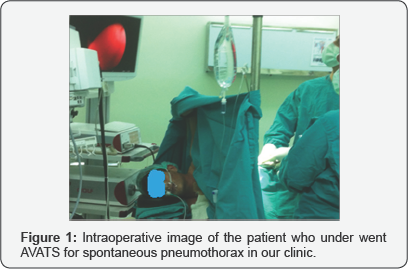Awake Non-entubated Video Assisted Thoracoscopic Surgery-Juniper publishers
JUNIPER PUBLISHERS-OPEN ACCESS INTERNATIONAL JOURNAL OF PULMONARY & RESPIRATORY SCIENCES
Abstact
Thoracic surgery developed in greater extent with
equipment sand techniques in one lung ventilation in the last decades.
Traditionally, VATS is performed under general anesthesia with selective
ventilation with double lumenendo trachealintubation. Awake
video-assisted thoracic surgery (AVATS) has been increasingly employed
in a variety of procedures involving pleura, lungs, and mediastinum.
Inthoracic surgery intubation and techniques without in tubation leads
different physiologic changes. Adequate anesthesia and analgesia
obtained from Thoracic Epidural Anesthesia (TEA), thoracic paravertebral
anesthesia(TPA), localanesthesia, intercostal nerve blocks with
/without sedoanalgesia allow VATS to be performed in awake patients.
AVATS has been demonstrated to be a safe option for thoracic procedures
with results rivalling and often exceeding thoracotomy or traditional
VATS. The procedure can have such advantages as early mobilization,
opening of early oral intake, early discharge, patient satisfaction, low
pain level. With careful patient selection, detailed preoperative
planning and calm, meticulous operative approach allows using the AVATS
technique in even more complex thoracic cases. Nevertheless, there is a
need for randomized controlled trials involving wider case series on the
subject.
Introduction
Thoracic surgery developed in greater extent with
equipments and techniques in one lung ventilation in the last decades.
Still general anesthesia in one lung ventilation approved as gold
standard. The reasons for preference of awake patient includes;
avoidance of several complications related to general anesthesia.
Inthoracic surgery most performed surgeries are plerural decortication
and lung biopsy. Avoidance of intubation in Video Assisted Thoracoscopic
Surgery (VATS) procedures gains us some advantages in post operative
period; a better respiratory outcome, survival and morbidity mortality
rates, reduce hospitalization time and costs, reduced early stress
hormone and immune response. Traditionally, VATS is performed under
general anesthesia with selective ventilation with double lumen
endotracheal intubation. Awake video-assisted thoracic surgery (AVATS)
has been increasingly employed in a variety of procedures involving
pleura, lungs, and mediastinum. Inthoracic surgery intubation and
techniques without intubation leads different physiologic changes. With
intubation diphragm is completely curarized and mechanical ventilation
takes in action. However in nonintubated techniques patients' breathe
spontanously and diaphragm muscle contracts
Awake VATS operations without mechanical ventilation
were earlier used only for pleural biopsy for diagnostic purposes.
However, by the advances in minimally invasive technology such as
spontaneous pneumothorax surgery, bullous emphysema, pulmonary nodule
resection of lung volume reduction surgery, the decortication, and
treatment of mediastinal mass and in lung anatomic resection, in recent
year simplementation of case series and randomized controlled trials are
available showing that AVATS is a safe and effective technique.
Adequate anesthesia and analgesia obtained from Thoracic Epidural
Anesthesia (TEA), thoracic paravertebral anesthesia (TPA), local
anesthesia, intercostal nerve blocks with /without sedoanalgesia allow
VATS to be performed in awake patients. The potential general
anesthesia-related adverse effects, such as intubation- relatedtrauma,
pneumonia, ventilator-associated lunginjury, effects of neuro muscular
blocking agents, and post operative nausea and vomiting, can thus be
avoided. Potential cases for AVATS technique performed with awake
regional anesthesia are minor cases for healthy patients and high-risk
cases where intubation is inconvenienttoapply. The short duration of the
operation and careful patient selection is necessary.

The unwillingness ofthe patient to be awaked uring
operation, a risk of contamination of the other lung, massive bleeding,
infectious conditions such as inflammation, alveolar proteinosis,
bronchopleural fistula is among the contra indications of the procedure.
In some demanding procedures surgeons prefer thoracicepidural
anesthesia which grants superior thoracic analgesia. Morover hypoxemia
and hyper capnia may still exist in nonin tubated thoracic surgery. In
later aldecubitus position AVATS preserves ventilation perfusion match
by ventilation of dependent he midiaphragm in comparison to intubated
one-lung ventilationunder general anesthesia. Usually mildhy
percapniamay ocur which is well-tolerated and when patient starts
two-lung breathing carbondioxide levels return to normal. Additional
oxygen therapy by a face mask usually sufficient after surgery. The
rates of general anesthesia and intubation are between 2.7% and 4.3%,
depending on the surgical procedure and learning curve applied. Some
current articles reported that in n case of awake technique, patient
satisfaction is more, pain levels are less,nursing care is less, the
length of hospital stay is shorter and it is safe and feasible surgery.
Early discharge, early mobilization and early oral intake is possible
with this procedure.
Those patients whose AVATS is contraindicated:
Hemodynamically unstable patients, expected difficult airway management
(Mallampati III-IV), obesity (BMI>30), intensive pleuraladhesions,
inexperienced surgical team in VATS, para- diaphragmaticlesions, large /
central pulmonarylesions (>6 cm), obstacles to the application of
thoracicparavertebral- epiuralanesthesia, psychological
aspectsareunstable. AVATS has been demonstrated to be a safe option for
thoracic procedures with results rivalling and often exceeding thoracoto
my ortraditional VATS. Pleural procedures, wed geresections and
lobectomies have been perfor medvia AVATS with good results but there
has been a paucity of reports regarding AVATS for more complex
procedures. Reported mortality rates in patients with malignancy
orpoorcardio pulmonary status are often shown to be highest and these
patients may benefit most from the AVATS approach. Inconclusion AVATS
procedure sare feasibile and safety with minimal adverseevents in the
appropriate patient group. The procedure can have such advantages as
early mobilization, opening of early oral intake, early discharge,
patient satisfaction, low pain level. With careful patient selection,
detailed preoperative planning and calm, meticulous operative approach
allows using the AVATS technique in even more complex thoraciccases.
To know more about Open Access International
Journal of Pulmonary & Respiratory Sciences please click on: https://juniperpublishers.com/ijoprs/index.php
To know more about Open access Journals
Publishers please click on : Juniper Publishers
To know more about juniper publishers: https://juniperpublishers.business.site/
Comments
Post a Comment